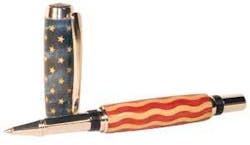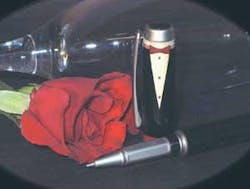Laser engraver helps entrepreneur write his future
David A. Belforte
Ken Nelsen, a woodworker by trade, was walking the floor of a woodworking show in Anaheim, California, in 1993, when his eye caught an exhibit featuring a laser engraving wood. What a neat idea, he thought, filing it away, even though his innate craftsman’s thinking had precipitated a number of ideas for things that one could do with this technology. Over the ensuing years he followed the growth of laser engraving both at trade shows and on the Web.
In 2003, as part of his job as a woodworker for various theaters, hotels, and resorts in the Las Vegas, Nevada, area, he was asked to produce a miniature wooden guitar to be used as promotion for a show featuring the entertainer Neil Diamond. The small size and fine details required for this piece were beyond his shop’s equipment capabilities, so he met with a friend’s wife who ran a small sign shop in the area, and who owned a small laser engraving system.
He created a layout in an AutoCAD program to cut the guitar shape and to engrave precise details such as the frets and fret markers. He was so impressed by the quality and precision this laser engraver could produce that he decided this was a technology with which he could make some money.
He set out to learn what was available in the market by accessing the Web, visiting trade shows, and tapping the knowledge of friends and associates. He narrowed his choices down to two U.S. laser system manufacturers, primarily because he had more confidence that domestic suppliers would be available to provide after-sales service, if needed.
After thoroughly investigating manufacturers he settled on Epilog Laser, a leading supplier of laser systems for non-metal processing, located in Golden, CO. He bought a Model 24EX, which was judged to have the power necessary to process the kinds of wood he had in mind and which had an engraving area-24 in. x 20 in.-he thought would handle most of the work sizes he contemplated.
As a lifelong woodworker he had an appreciation for the types of wood that could be used in decorative projects, especially the densities of exotic woods and how they could be laser processed. Mind you, at this point in time he still didn’t have a specific product or market for products in mind. In fact he laughingly recalls the response he received from laser system sales people who often questioned what he had in mind for the laser when he had told them nothing specific.
The unit was installed in his Las Vegas home early in 2003 and he formed a new company named Kallenshaan Woods (www.kallenshaanwoods.com), a stylization of the names of his two sons, Colin and Sean. With the intention to continue his day job while he learned how to use the laser, he set out over the first couple of months to understand everything about this unit and what it could do before he tested the market.
During this learning period he experimented with all types of materials, especially woods, producing a variety of key chains, picture frames, and other giftware items he observed would be the most likely business to get him started. And he was right. Orders flowed in, mostly from the Website that he set up, and he quickly became a supplier to the general local population that had interest in specialty gifts. But he knew that this business was very competitive and that he would have to find a market niche that a) was not seasonal and b) could generate sufficient volumes to allow for planned production schedules.
At a woodworking trade show in Utah he made contact with a number of people who either as a hobby or avocation produced custom writing pens. These people, termed penturners in the industry, used exotic woods, polished to a high degree along with fancy nibs and other pen hardware to customize pens that could sell for up to $200. Some of these penturners were using inlays to produce fancy pens, and Nelsen noted that he could probably produce wood inlays, using laser cutting, that would fit better and would have more intricate shapes.
A word here about penturners; it turns out that there is a vast sub-culture of these people who are interested in making, collecting, selling, and working with fancy pens. You can find a multitude of references on the Internet, so it is easy to understand why he (also a penturner) singled out this market niche for products that could be turned out with his laser.
It wasn’t as though others didn’t have the same thought, providing laser cut wood inlay material to this market. The problem they faced was that their products, flat cut inlay shapes, were unable to tightly fit into the opening left in the pen material because the pens are cylindrical and the inlay area is laser engraved using a rotary attachment, while the inlays are cut flat. So unless you can cut inlay material from a cylinder it was not going to produce a clean, tight-fitting product, because the engraved walls on the pen are tapered toward the center of the cylinder and the walls of the inlays are straight sided.
This is where Nelsen’s unique training as a woodworker and his ability to visualize a problem and to create a fixture to resolve it allowed him to open a niche in the penturners market that he now fully exploits. He used the Epilog system’s versatility to produce an acrylic jig that allowed him to equally space a design around the entire pen so that he could turn the pen one notch, engrave an area, turn the pen, and engrave another area and so forth, producing a straight sided cut edge. In this manner he could accommodate almost any number of stops around a cylinder so that he could engrave a section of the pen and then turn the jig one section, always knowing he was engraving an equal portion of the pen.
Now he can quickly put together pen kits that can be built by anyone wanting to be a penturner. An assortment of his work is shown in the photos accompanying this article. This has increased his business to the point where he is now about to phase out his day job and become a full-blown laser cutting company, even to possibly hiring additional personnel. Adding to the career change may be relocation to an ocean view as he plans to forsake the desert for a more personally satisfying locale. The portability of the laser-it is only 38 in. x 32.5 in. x 40 in., weighs 350 lbs, and works off simple 110-volt, 15-amp household power-helps to make this possible.
Nelsen ([email protected]) still does the occasional giftware or award engraving job but he realizes that he needs to expand his specialty business, such as the inlay kits for penturners, in order to sustain a business that can support his family. And he is anxious to get away from working 18-hour days between the day job and the burgeoning laser cutting business. Over the past few months, as he struggled to serve the 400 or so customers, most of which are repeats, he realized that the day job, although self fulfilling, has to end. His head is brimming with ideas on how to expand the laser engraving business and from the penturners experience; it would appear that his talents will carry him to the self-employed level, enjoying the ocean view somewhere, driven by laser technology.


